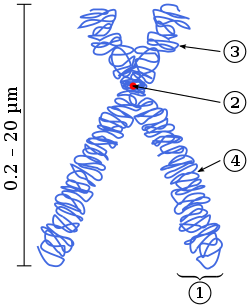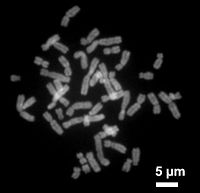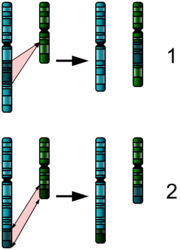A chromosome is an organized structure of DNA and protein that is found in cells. A chromosome is a single piece of DNA that contains many genes, regulatory elements and other nucleotide sequences. Chromosomes also contain DNA-bound proteins, which serve to package the DNA and control its functions. The DNA molecule may be circular or linear, and can contain anything from 10,000 to 1,000,000,000 nucleotides in length. Typically eukaryotic cells (cells with nuclei) have large linear chromosomes and prokaryotic cells (cells without defined nuclei) have smaller circular chromosomes, although there are many exceptions to this rule. Furthermore, cells may contain more than one type of chromosome; for example, mitochondria in most eukaryotes and chloroplasts in plants have their own small chromosomes. In eukaryotes, nuclear chromosomes are packaged by proteins into a condensed structure called chromatin. This allows the very long DNA molecules to fit into the cell nucleus. The structure of chromosomes and chromatin varies through the cell cycle. Chromosomes may exist as either duplicated or unduplicated—unduplicated chromosomes are single linear strands, whereas duplicated chromosomes (copied during synthesis phase) contain two copies joined by a centromere. Compaction of the duplicated chromosomes during mitosis and meiosis results in the classic four-arm structure (pictured to the right).
"Chromosome" is a rather loosely defined term. In prokaryotes, a small circular DNA molecule may be called either a plasmid or a small chromosome. These small circular genomes are also found in mitochondria and chloroplasts, reflecting their bacterial origins. The simplest chromosomes are found in viruses: these DNA or RNA molecules are short linear or circular chromosomes that often lack any structural proteins.
History
This is a brief history of research in a complex field where each advance was hard won, and often hotly disputed at the time.
Visual discovery of chromosomes. Textbooks have often said that chromosomes were first observed in plant cells by a Swiss botanist named Karl Wilhelm von Nägeli in 1842. However, this opinion has been challenged, perhaps decisively, by Henry Harris, who has freshly reviewed the primary literature. In his opinion the claim of Nägeli to have seen spore mother cells divide is mistaken, as are some of his interpretations. Harris considers other candidates, especially Wilhelm Hofmeister, whose publications in 1848-9 include plates that definitely show mitotic events. Hofmeister was also the choice of Cyril Darlington.
The work of other cytologists such as Walther Flemming, Eduard Strasburger, Otto Bütschli, Oskar Hertwig and Carl Rabl should be acknowledged. The use of basophilic aniline dyes was a new technique for effectively staining the chromatin material in the nucleus. Their behavior in animal (salamander) cells was later described in detail by Walther Flemming, who in 1882 "provided a superb summary of the state of the field." The name chromosome was invented in 1888 by Heinrich von Waldeyer. However, van Beneden's monograph of 1883 on the fertilised eggs of the parasitic roundworm Ascaris megalocephala was the outstanding work of this period. His conclusions are classic:
- Thus there is no fusion between the male chromatin and the female chromatin at any stage of division....
- The elements of male origin and those of female origin are never fused together in a cleavage nucleus, and perhaps they remain distinct in all the nuclei derived from them. [tranl: Harris p162]
"It is not easy to identify who first discerned chromosomes during mitosis, but there is no doubt that those who first saw them had no idea of their significance... with the work of Balbiani and van Beneden we move away from... the mechanism of cell division to a precise delineation of chromosomes and what they do during the division of the cell."
Van Beneden's master work was closely followed by that of Carl Rabl, who reached similar conclusions. This more or less concludes the first period, in which chromosomes were visually sighted and the morphological stages of mitosis were described. Coleman also gives a useful review of these discoveries.
Nucleus as the seat of heredity. The origin of this epoch-making idea lies in a few sentences tucked away in Ernst Haeckel's Generelle Morphologie of 1866. The evidence for this insight gradually accumulated until, after twenty or so years, two of the greatest in a line of great German scientists spelled out the concept. August Weismann proposed that the germ line is separate from the soma, and that the cell nucleus is the repository of the hereditary material, which, he proposed, is arranged along the chromosomes in a linear manner. Furthermore, he proposed that at fertilisation a new combination of chromosomes (and their hereditary material) would be formed. This was the explanation for the reduction division of meiosis (first described by van Beneden).
Chromosomes as vectors of heredity. In a series of outstanding experiments, Theodor Boveri gave the definitive demonstration that chromosomes are the vectors of heredity. His two principles were:
- The continuity of chromosomes
- The individuality of chromosomes.
It was the second of these principles that was so original. Boveri was able to test the proposal put forward by Wilhelm Roux, that each chromosome carries a different genetic load, and showed that Roux was right. Upon the rediscovery of Mendel, Boveri was able to point out the connection between the rules of inheritance and the behaviour of the chromosomes. It is interesting to see that Boveri influenced two generations of American cytologists: Edmund Beecher Wilson, Walter Sutton and Theophilus Painter were all influenced by Boveri (Wilson and Painter actually worked with him). In his famous textbook The Cell, Wilson linked Boveri and Sutton together by the Boveri-Sutton theory. Mayr remarks that the theory was hotly contested by some famous geneticists: William Bateson, Wilhelm Johannsen, Richard Goldschmidt and T.H. Morgan, all of a rather dogmatic turn-of-mind. Eventually complete proof came from chromosome maps – in Morgan's own lab.
Chromosomes in eukaryotes
Eukaryotes (cells with nuclei such as plants, yeast, and animals) possess multiple large linear chromosomes contained in the cell's nucleus. Each chromosome has one centromere, with one or two arms projecting from the centromere, although, under most circumstances, these arms are not visible as such. In addition, most eukaryotes have a small circular mitochondrial genome, and some eukaryotes may have additional small circular or linear cytoplasmic chromosomes.
In the nuclear chromosomes of eukaryotes, the uncondensed DNA exists in a semi-ordered structure, where it is wrapped around histones (structural proteins), forming a composite material called chromatin.
Chromatin
Chromatin is the complex of DNA and protein found in the eukaryotic nucleus which packages chromosomes. The structure of chromatin varies significantly between different stages of the cell cycle, according to the requirements of the DNA.
Interphase chromatin
During interphase (the period of the cell cycle where the cell is not dividing) two types of chromatin can be distinguished:
- Euchromatin, which consists of DNA that is active, e.g., expressed as protein.
- Heterochromatin, which consists of mostly inactive DNA. It seems to serve structural purposes during the chromosomal stages. Heterochromatin can be further distinguished into two types:
- Constitutive heterochromatin, which is never expressed. It is located around the centromere and usually contains repetitive sequences.
- Facultative heterochromatin, which is sometimes expressed.
Individual chromosomes cannot be distinguished at this stage - they appear in the nucleus as a homogeneous tangled mix of DNA and protein.
Metaphase chromatin and division
In the early stages of mitosis or meiosis (cell division), the chromatin strands become more and more condensed. They cease to function as accessible genetic material (transcription stops) and become a compact transportable form. This compact form makes the individual chromosomes visible, and they form the classic four arm structure, a pair of sister chromatids attached to each other at the centromere. The shorter arms are called p arms (from the French petit, small) and the longer arms are called q arms (q follows p in the Latin alphabet). This is the only natural context in which individual chromosomes are visible with an optical microscope.
During divisions long microtubules attach to the centromere and the two opposite ends of the cell. The microtubules then pull the chromatids apart, so that each daughter cell inherits one set of chromatids. Once the cells have divided, the chromatids are uncoiled and can function again as chromatin. In spite of their appearance, chromosomes are structurally highly condensed, which enables these giant DNA structures to be contained within a cell nucleus (Fig. 2).
The self-assembled microtubules form the spindle, which attaches to chromosomes at specialized structures called kinetochores, one of which is present on each sister chromatid. A special DNA base sequence in the region of the kinetochores provides, along with special proteins, longer-lasting attachment in this region.
Chromosomes in prokaryotes
The prokaryotes - bacteria and archaea - typically have a single circular chromosome, but many variations do exist. Most bacteria have a single circular chromosome that can range in size from only 160,000 base pairs in the endosymbiotic bacteria Candidatus Carsonella ruddii, to 12,200,000 base pairs in the soil-dwelling bacteria Sorangium cellulosum. Spirochaetes of the genus Borrelia are a notable exception to this arrangement, with bacteria such as Borrelia burgdorferi, the cause of Lyme disease, containing a single linear chromosome.
Structure in sequences
Prokaryotic chromosomes have less sequence-based structure than eukaryotes. Bacteria typically have a single point (the origin of replication) from which replication starts, whereas some archaea contain multiple replication origins. The genes in prokaryotes are often organized in operons, and do not usually contain introns, unlike eukaryotes.
DNA packaging
Prokaryotes do not possess nuclei. Instead, their DNA is organized into a structure called the nucleoid. The nucleoid is a distinct structure and occupies a defined region of the bacterial cell. This structure is, however, dynamic and is maintained and remodeled by the actions of a range of histone-like proteins, which associate with the bacterial chromosome. In archaea, the DNA in chromosomes is even more organized, with the DNA packaged within structures similar to eukaryotic nucleosomes.
Bacterial chromosomes tend to be tethered to the plasma membrane of the bacteria. In molecular biology application, this allows for its isolation from plasmid DNA by centrifugation of lysed bacteria and pelleting of the membranes (and the attached DNA).
Prokaryotic chromosomes and plasmids are, like eukaryotic DNA, generally supercoiled. The DNA must first be released into its relaxed state for access for transcription, regulation, and replication.
Number of chromosomes in various organisms
Eukaryotes
These tables give the total number of chromosomes (including sex chromosomes) in a cell nucleus. For example, human cells are diploid and have 22 different types of autosomes, each present as two copies, and two sex chromosomes. This gives 46 chromosomes in total. Other organisms have more than two copies of their chromosomes, such as Bread wheat, which is hexaploid and has six copies of seven different chromosomes - 42 chromosomes in total.



















No comments:
Post a Comment